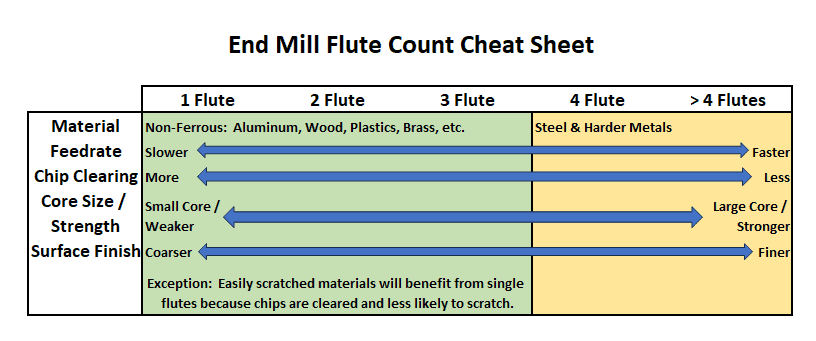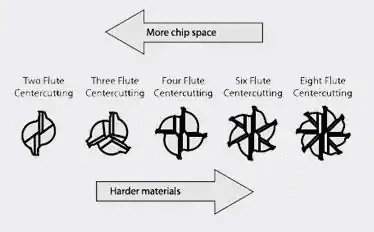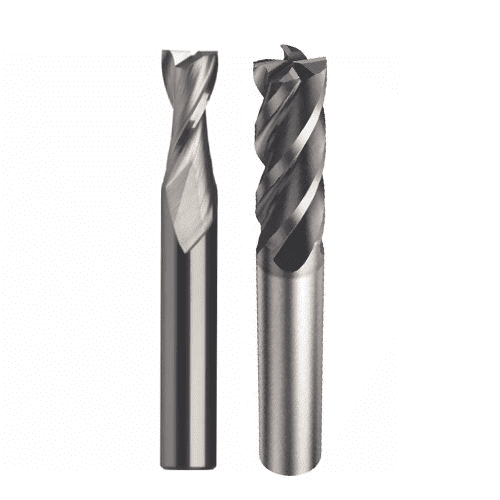In the world of machining, the perfect end mill can make all the difference between a successful project and one riddled with complications. But how do you choose the right end mill for your specific application?
In this comprehensive guide, we’ll delve into the world of “2 flute vs 4 flute” end mills (and all the other flute counts), exploring their unique benefits, limitations, and specialized features.
By the end of this journey, you’ll be well-equipped to make informed decisions and select the ideal end mill for your next machining project.
Key Takeaways
- Understanding flute count is essential for selecting the right end mill.
- 2 flute and 4 flute end mills offer different performance benefits, depending on material type and machining operation.
- Specialized features such as high helix angles and corner radius can improve tool strength, chip evacuation, cutting forces & surface finish.
End Mill Flute Count Cheat Sheet

Understanding Flute Count

Flute count, number of valleys, and valley width
Flute count plays a crucial role in end mill performance, affecting core size, durability, chip evacuation, and surface finish. Understanding the basics of flute count is essential for selecting the right tool, whether you’re working with aluminum or steel, roughing or finishing.
Let’s dive into the world of flute count and discover what it means for your machining operations.
Flute Count Basics
Flute count is a term that describes the number of cutting edges on an end mill, such as four flute mills. The general rule is to use 4 flutes for machining steel and harder alloys, as they have smaller flute valleys, which provide less chip evacuation.
On the other hand, 2 flutes are commonly used for machining aluminum and non-ferrous materials, offering a longer tool life. Various coatings like TiN, TiCN, AlTiN, and Diamond finishes are available for 2-flute end mills, further enhancing their performance.
So, why is the flute count important? It has a direct impact on core size, strength, chip evacuation, and surface finish, especially when using a 2 flute end mill. More flutes mean a larger core and increased tool strength, making it suitable for virtually any material.
However, more flutes also reduce the flute valleys that facilitate chip evacuation during machining. End mills with higher flute counts are better for machining tougher materials that require a smaller rate of metal to be removed. This makes them ideal for handling harder, more ferrous materials.
Cutting Edges and Flute Depth
The number of cutting edges and flute depth in an end mill can significantly impact its ability to remove material. For roughing operations, a lower flute count is recommended to ensure that the flute valley is large enough to adequately evacuate chips. In contrast, high flute count end mills are suitable for finishing applications, as they are able to remove smaller amounts of material while not being affected by chip evacuation.
The relationship between flute count and material removal rate is clear: a higher flute count produces smoother finishes, whereas a lower count enables faster material removal. Understanding this relationship is crucial for selecting the right end mill based on the desired surface finish and material removal rate in your machining application.
Comparing 2 Flute and 4 Flute End Mills

2 flute vs 4 flute end mills...
2 flute and 4 flute end mills are commonly used in machining applications, each offering unique benefits and limitations depending on the material and operation. In the following sections, we’ll explore these differences in greater detail, helping you make an informed decision when choosing between 2 flute and 4 flute end mills for your specific needs.
Understanding the differences between 2 flute and 4 flute end mills is essential for selecting the right end mill.
2 Flute End Mills
2 flute end mills are designed for milling grooves or slots in softer materials such as aluminum. They offer effective chip evacuation and higher material removal rates due to their larger gullet for enhanced chip clearance. Solid carbide 2 flute end mills, in particular, provide superior hardness, strength, and wear resistance, making them ideal for working with wood and aluminum.
When working with softer materials, 2 flute end mills are your go-to choice for roughing applications, ensuring efficient material removal and a quicker cutting speed. The larger chips generated by 2 flute end mills also contribute to their suitability for roughing operations.
4 Flute End Mills
4 flute end mills, on the other hand, are designed for harder materials such as steel, providing increased tool strength, smoother finishes, and higher feed rates than 2 flute end mills. They are more suitable for slotting applications on steel, stainless steel, high temperature alloys, and iron.
Four-flute end mills are well-suited for high-speed cutting of hard materials, such as iron, alloys, and other similar substances, due to their strong resistance to heat and their ability to cut more efficiently through the material’s microstructure. Enhancing the rate at which the metal is taken away from the workpiece, 4 flute end mills are a great option for general-purpose cutting and finishing work.
Single Flute and 3 Flute End Mills
You can get single flute and 3 flute end mills, but when should they be used?
Turns out they're great for non-ferrous metals, plastics, and softer materials. The single flutes can clear chips from stringy sticky aluminum. They also reduce recutting of chips and evacuate the chips faster, which improves surface finish by reducing the likelihood that chips already cut will scratch the workpiece.
Three flutes are a performance-enhancing alternative to 2 flute end mills. Their extra flute gives them a faster feed rate for a given surface speed. They're ideal for aluminum roughing applications.
End Mills with more than 4 Flutes
You can get end mills with very large numbers of flutes indeed. They're ideal for really tough materials such as titanium, high temp nickel alloys, and stainless steels. Such materials usually can't be spun very fast without burning up your cutters. Having more flutes keeps the feedrates up so that material removal rates can be higher despite the lower spindle rpms.
Factors to Consider When Choosing Flute Count
When choosing the appropriate flute count, consider factors such as material type, machining operation, and tool life to ensure optimal performance.
In the next sections, we’ll explore each factor in more detail, guiding you on how to select the best end mill for your specific application.
Material Type
Material type plays a significant role in determining the ideal flute count. Softer materials like aluminum, wood, and plastics benefit from fewer flutes, as they generate larger chips and offer better chip evacuation. On the other hand, harder materials like steel, cast iron, and high-temp alloys require more flutes for increased strength and wear resistance.
Understanding the material you’re working with is crucial for selecting the right flute count. By choosing the appropriate end mill, you can optimize machining performance, tool life, and surface finish, ensuring a successful and efficient project outcome.
Machining Operation
The machining operation, whether roughing or finishing, also influences the choice of flute count. As we’ve seen earlier, lower flute counts are more suitable for roughing operations, offering efficient chip removal and faster material removal rates. Conversely, higher flute counts are recommended for finishing operations, providing smoother finishes and reduced cutting forces.
By understanding the type of machining operation you’re performing, you can select the appropriate flute count to optimize performance, tool life, and surface finish, ultimately ensuring a successful and efficient project outcome.
Sneaky Trick: Using More Flutes in Aluminum
Here's a sneaky trick: when peripheral milling in aluminum, you may be able to get away using more flutes, and hence higher feedrates. The trick is to only use 4 flutes when peripheral machinining so as not to jam up the chips. When peripheral machining, only the side of the end mill is being used and it isn't buried down in a tight slot where chips can jam up.
For more info on this sneaky trick, see our article on performance recipe for aluminum.
Tool Life and Performance
Tool life and performance are also affected by flute count. Higher flute counts offer longer tool life and better performance in certain materials and applications, such as when working with harder materials like steel or cast iron.
Selecting the right flute count for your specific application can significantly impact the longevity and performance of your end mill. By taking into account factors like material type, machining operation, and specialized features, you can optimize tool performance and extend tool life, ultimately saving time and resources.
Specialized End Mill Features
In addition to the flute count, specialized end mill features, such as high helix angles and corner radius, can further enhance tool performance and adaptability. These specialized features can help improve chip evacuation, reduce cutting forces, and provide a more durable cutting edge.
Let’s take a closer look at these specialized end mill features and their benefits.
High Helix Angle
High helix angle end mills provide improved chip evacuation and reduced cutting forces, making them suitable for materials prone to chip buildup and heat generation. The purpose of a high helix angle is to enhance stock removal and machining performance at increased speeds and feeds.
When working with materials like aluminum, stainless steel, or other materials that generate excessive heat and chip buildup, high helix angle end mills can be an invaluable tool in your arsenal, ensuring efficient metal removal and reduced cutting forces for optimal performance.
Corner Radius
Corner radius end mills offer increased tool strength and reduced wear, particularly in applications that involve heavy milling or aggressive cutting conditions. The purpose of corner radius in end mills is to prevent chipping or breaking down of the corners, distribute cutting forces evenly, and extend the functional tool life.
In applications with heavy milling or aggressive cutting conditions, corner radius end mills can be a valuable asset, providing greater tool strength, reduced wear, and improved surface finish. By considering specialized features like corner radius and high helix angles, you can ensure optimal tool performance and longevity in your machining projects.
Selecting the Right End Mill for Your Application
Selecting the right end mill for your application involves considering factors such as flute count, material type, machining operation, and specialized features to ensure optimal tool performance and longevity. By understanding the specific requirements of your machining project and the unique characteristics of each end mill type, you can make an informed decision and choose the right tool for the job.
Remember that the length of cut should only be as long as necessary, and the shortest tool possible should be selected to minimize overhang and reduce chatter. By carefully considering all these factors, including the cutting end, you can select the ideal end mill for your specific application, ensuring a successful and efficient project outcome.
Summary
In conclusion, choosing the right end mill for your specific machining application is crucial for ensuring optimal performance, tool life, and surface finish. By understanding the importance of flute count, material type, machining operation, and specialized end mill features, you can make informed decisions and select the ideal end mill for your next project. Remember that the right end mill can make all the difference between a successful project and one riddled with complications. Equip yourself with the knowledge and tools to make the best choice, and watch your machining projects soar to new heights.
Frequently Asked Questions
What is the difference between a 2 flute and 4 flute end mill?
Two flute end mills are mainly used for machining aluminum and non-ferrous materials, while four flutes are most suitable for machining steel and harder alloys.
Is a 2 flute or 4 flute better for cutting wood?
For cutting wood, 2 flutes are preferable.
What is a 2 flute end mill used for?
2 Flute End Mills are primarily used for center cutting operations and when chip removal in slots and grooves is a problem. This largely happens in non-ferrous materials.
Are more flutes better on an end mill?
More flutes on an end mill means better finish, higher strength, and faster feed rates. However, there is a limit to how many flutes may be used depending on the material. Aluminum and other non-ferrous metals typically require 3 or fewer flutes to ensure proper chip clearing.
Be the first to know about updates at CNC Cookbook
Join our newsletter to get updates on what's next at CNC Cookbook.